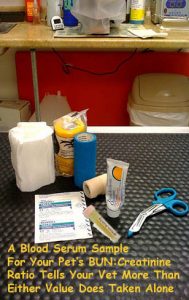Ron Hines DVM PhD
Your Dog And Cat’s BUN to Creatinine Ratio = BUN/Cr = BUN:Cr Ratio
Mathematically calculating the ratio between the amount of BUN/urea and the amount of creatinine in your dog or cat’s blood gives your veterinarian clues as to why your pet’s blood urea nitrogen level (BUN) might be elevated. The question is “is it your pet’s kidneys that are the problem or is it something else?” Both BUN and Creatinine are metabolic wastes that your dog or cat needs to clear from its blood through its kidneys and urine. I mention many of the causes of high BUN level here and creatinine level here. Many kidney-related causes can be ruled out or ruled in when BUN is considered in its ratio to your pet’s creatinine level. The two values should go up or down in tandem when kidney or urinary tract problems are your pet’s underlying issue. In those cases, the ratio value should also remain similar over time. When one is out of balance with the other, health problems outside your pet’s urinary tract might need to be explored.
The normal BUN to Creatinine ratio for dogs ranges from ~4-27. The normal BUN to Creatinine ratio for cats ranges from 4 to 33. The normal BUN value for dogs is between ~7-26 mg/dl. The Normal BUN value for cats is ~14-36. The normal blood creatinine level for dogs is ~0.5-1.6 mg/dl. The normal blood creatinine level for cats is ~0.8-2.0 mg/dl. (mg/dl = milligrams per deciliter) What is considered the “normal range” varies a bit depending on the laboratory reporting the results or the in-hospital analyzer your veterinarian is using. The averages I give in this article are taken from some of my 2022 dog and cat lab reports.
Why Might My Pet’s BUN:Creatinine Ratio Be High?
A modestly elevated BUN/Creatinine ratio sometimes just means that your dog or cat was dehydrated when the blood sample was collected. In those cases, and when other laboratory tests and your veterinarian’s physical exam detects no other issues, a second test at a later date should confirm that the first one was a transient event. When dehydration was the cause of a high reading, your pet’s hematocrit would probably be a bit elevated too. However, if the number is markedly elevated, an acute kidney injury might have occurred. Perhaps because of a traumatic event such as a car accident or perhaps due to the consumption of a toxic substance.
Events that cause your pet’s BUN to Creatinine ratio to go up are events that cause your pet’s BUN to increase but cause little or no increase in its creatinine level. Those events include bleeding into its intestine or pockets of blood in its body or under its skin subsequent to trauma or surgery. Much of that blood is later reabsorbed and the protein in it red blood cells generates more BUN. Pets with this reason for a high BUN/creatinine number would most likely be anemic as well. Certain medications, including corticosteroids, azathioprine and tetracycline can result in an elevated BUN that raises your pet’s BUN to Creatinine ratio. Other health issues that have been associated with an increase in your pet’s BUN to Creatinine ratio include shock, heart failure, a very high-protein diet, and advancing age.
Why Might My Pet’s BUN:Creatinine Ratio Be Low?
A low BUN/creatinine ratio is most likely due to refusal to eat, starvation, malnutrition, advanced liver disease or even late pregnancy.
DxMe
You are on the Vetspace animal health website
Visiting the products that you see displayed on this website help pay the cost of keeping these articles on the Internet.
